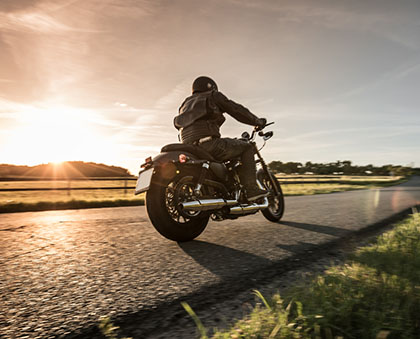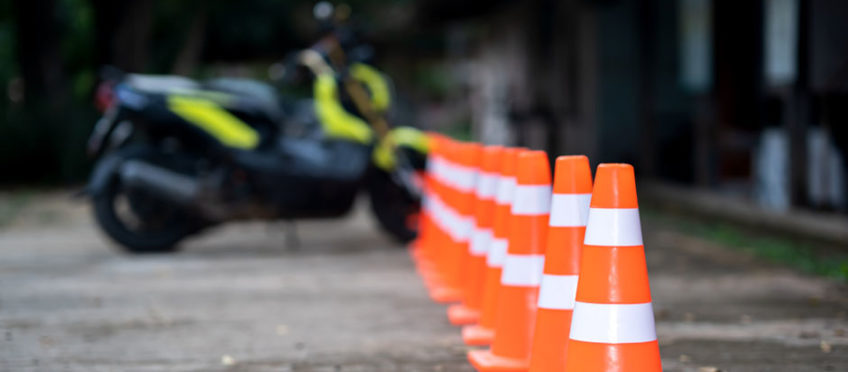Rare is the rider who hasn’t dropped their motorcycle. It’s a horrible, sickening feeling to feel yourself losing your balance and control, knowing there’s nothing you can do to stop your bike from falling over.
The most common damages are rattled confidence, wounded pride, and scrapes and dents on your bike, although injuries can be more serious. As innocuous as shattered confidence seems on the surface, it can make it hard to get back in the saddle. It can also infiltrate other areas of your life.
Anyone can ride fast in a straight line. The motorcycle can even keep itself up for a while. But it takes a great deal of skill to ride a heavy motorcycle proficiently at slow speeds, like when you’re pulling into a driveway or parking spot, stopping or turning at an intersection, or maneuvering through traffic.
Here’s what to do when you drop your bike:
1. Own it. The sooner you take charge and approach the situation from a place of personal power, the easier it is to get back on. You made an error (or two) and you’ve just learned how important it is to keep your skills sharp and stay focused on what’s going on around you.
2. Take charge. Assess your physical and emotional state and the bike for damage. Pick it up, with help if necessary, and move it out of traffic to give it a better inspection. Make sure you’re both okay before continuing.
3. Recognize you’re not the only one who’s experienced this. Most riders, even those with years of experience, drop their bike occasionally. It’s heavy to manage at low speeds and once it leans past the tipping point, you can’t hold it up.
4. Take a skills improvement course through a professional organization with qualified instructors, especially if you’re dropping your bike frequently. If you haven’t taken the basic rider course, start there. Experienced riders can benefit from a skills refresher. Friends and family mean well and can get you started, but they often don’t know what to look for or how to apply best learning techniques. You’re already stressed from the drop and their emotional attachment will get in the way of your learning. You can’t afford that with so much at stake. An added bonus is that some insurance companies offer discounts for new riders who’ve successfully completed a recognized course.
 5. Consult with an expert to figure out what went wrong and how to minimize the chances of a recurrence. The most likely culprits are improper coordination of the throttle and clutch, improper application of brakes, especially the front, and incorrect eye focus. Others include poorly executed quick stops and loss of footing on gravel or oil at stops.
5. Consult with an expert to figure out what went wrong and how to minimize the chances of a recurrence. The most likely culprits are improper coordination of the throttle and clutch, improper application of brakes, especially the front, and incorrect eye focus. Others include poorly executed quick stops and loss of footing on gravel or oil at stops.
6. Evaluate whether your bike is right for you. Make sure you’re comfortable with the fit, configuration, and your ability to manage its power. All motorcycles seem big when you’re learning, but it’s important to make sure it’s not beyond your current skill level.
7. Evaluate your gear and the roadworthiness of your motorcycle. Both can contribute to difficulty handling your bike, especially at slow speeds. Ill-fitting gloves can hamper dexterity, responsiveness, and use of controls. A poor fit of any gear creates discomfort and distraction. Ankles are vulnerable in tip overs so wear boots with solid support and oil-resistant soles for good traction at stops. Making sure your bike is mechanically fit increases your confidence that it will perform predictably and consistently.
8. Practice slow speed maneuvers in a parking lot with a friend. A lot. Even after you’ve taken a course. Repeated practice develops muscle memory so that when you need to call on those skills, they’re automatic. You’ll imprint what you practice so make sure you’ve learned from a qualified instructor.
9. Be patient with yourself and persistent in working through unhealthy fear. It may take time to regain your confidence. Remind yourself you’ve got the skills and you’ve learned an embarrassing lesson. Congratulate yourself on your progress, no matter how small.
10. Make sure you know how and where to carry extra weight, like luggage, camping gear, or groceries. Motorcycles tip over because they lose their balance. Their design takes weight distribution into account for best handling under normal operating conditions. If you distribute weight unevenly or add it up high, it’s harder to balance at slow speeds.
11. Be honest with yourself about your interest in riding. If the only reason you’re riding is because your friends are or because someone else wants you to ride, consider the tip over a not-so-subtle hint to hand over your keys. If you really don’t want to ride, don’t resist the voice of your intuition.
Set yourself up for success by following the tips above. Motorcycling is challenging, demanding, and so exhilarating! Whatever happens and what you learn about yourself on a motorcycle, both strengths and challenges, carry over into other parts of your life. Learn from your mistakes and move forward. Keep your head high and your eyes up. A lifetime of adventure awaits!








…I am looking fir ways to pick my pick back up..have ridden for years and now i find I am dropping the 750 sabre I just bought and unable to pick it up once it has gone over..never dropped a bike in the past unless I hit something really bad..but that was when I was in my 20`s ..now I am late fifties and practicing slow speed maneuvers in my back yard..but if the bike goes over ( in the grass) nothing gets hurt except my ego..so nothing important. The tricks of my back on the seat just doesn`t seem to work by myself. I had to get a long tube of steel and with help, pry it back up thru the front roll bar.